Last Chance to Catch NYC's Holiday Notalgia Train
We met the voices of the NYC subway on our nostalgia ride this weekend!


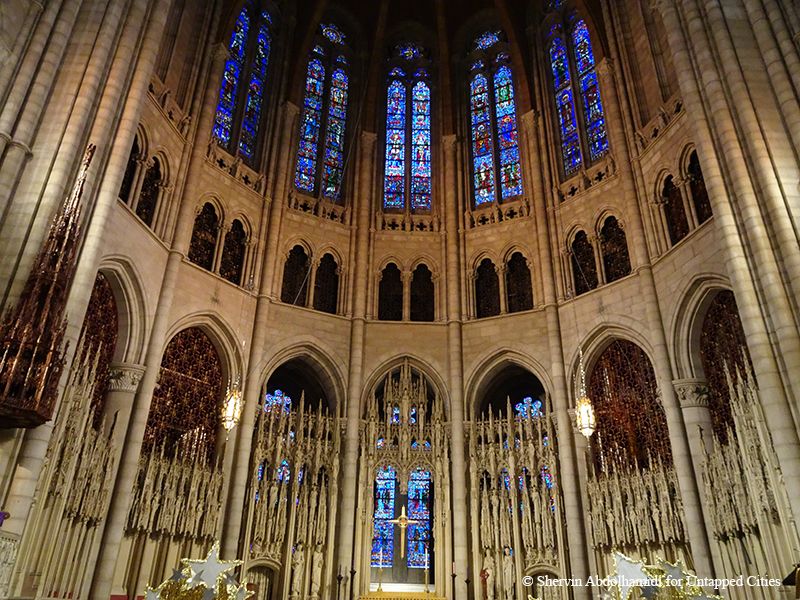
Looming in the skyline of Morningside Heights near Columbia University is a massive church that dominates the skyline of Hudson River waterfront. Riverside Church is an interdenominational church that serves as an inclusive place of congregation for over forty ethnic groups. Opened in 1930, the church has always been an active advocate in various social rights movements, including LGBT movements, immigration rights, and anti-torture campaigns. In accordance with their social justice advocacy and very inclusive ideology, Riverside Church has hosted numerous world-renowned guest speakers. Some notable speakers include Bill Clinton, Secretary-General of the United Nations Kofi Annan, who spoke there after the September 11 attacks, Cesar Chavez, Nelson Mandela, and the Dalai Lama.
On January 21st, Riverside Church marched with thousands of New Yorkers in solidarity with the National Women’s March on Washington to fight against intolerance and civil liberties, as is their hallmark. Recently, we had a chance to tour Riverside Church and even ascend to the 20th floor of this magnificent edifice with the New York Adventure Club.
Here are ten secrets of Riverside Church that you might not know:
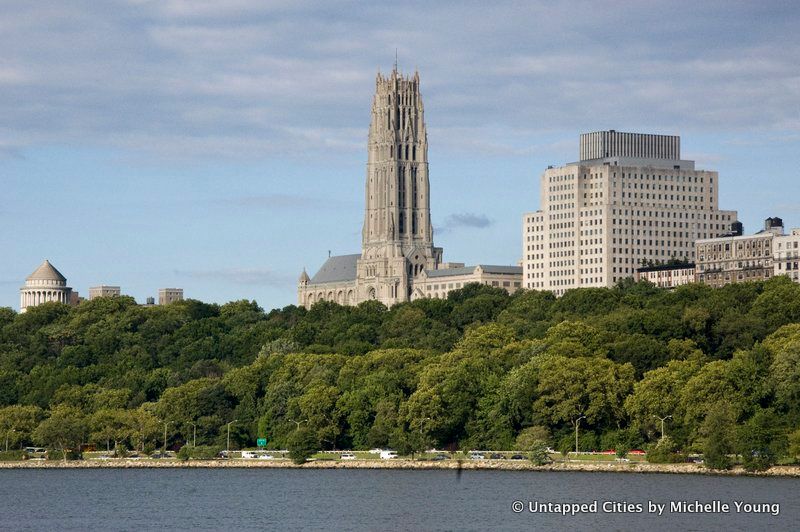
Riverside Church was designed by the firm of Allen, Pelton and Collens. Inspired by a famous French cathedral, Riverside Church is the tallest in the United States, and 24th in the world, with the stunning bell tower standing at 392 feet tall. The 22-story tower is modeled after one of the towers at Laon Cathedral in France, except with a base of 100 feet.
The Riverside Church bell tower was once accessible to the public via an observation deck which closed to the public after 9/11. The observation deck opened once again for the first time in nearly twenty years in December 2019. Eric Nash’s 1999 edition of Manhattan Skyscrapers still makes reference to the public observation deck, 355 feet high “served by the tallest elevators of any church in the world.”
Like the Woolworth Building, another neo-Gothic building, the structure of Riverside Church is supported by steel frames, much like office buildings in midtown, with the facade having a purely aesthetic value. The floors of the church host the religious institution’s numerous social and philanthropic activities, in addition to being used as administration space. The floor space is used to host events, Bible study sessions, and even book club meetings.
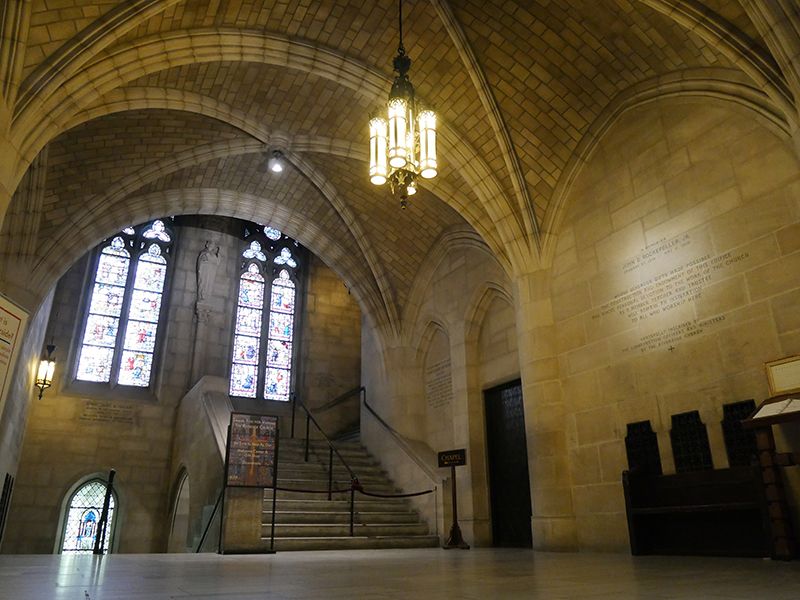
Image via New York Adventure Club by Corey William
Since its inception, Riverside Church has portrayed more liberal sentiments and ideologies that, according to the book The History of Riverside Church in New York, ran “contrary to the sensitivities and beliefs of earlier Protestant theology, [and] implied a synthetic relationship between religion and culture.”
One fun fact that attests to the multi-use of the church is that it used to have four bowling alleys in the basement of the church. In 1938, Columbia University students could head to the church for an afternoon of bowling in what is a rather unorthodox college student hangout venue. There was also even a Columbia physical education class held in the church basement. Unfortunately for students and the community today, the bowling alleys are no longer there.
Check out 7 hidden bowling alleys throughout NYC.

The tower of Riverside Church houses a carillon of bells that were initially installed in 1925, with more bells added later. In total, carillon boasts a total of 74 bronze bells, which at the time was the largest carillon of bells in the world. A carillon is a sets of chromatically tuned bells that span more than two octaves, or 23 bells.
The carillon was donated by John D. Rockefeller Jr. in memory of his mother, Laura Spelman Rockefeller. While the Laura Spelman Rockefeller memorial Carillon may no longer be the largest in the world, the church’s bourdon is 20-ton piece of bronze that is the largest cast and tuned bell up to this day.
Hyechon College Carillon, Seoku, Taejon, South Korea currently holds the record for largest number of bells with 78 bells and the Kick in the Hills in Michigan comes in second with 77 bells. There are less than 200 carillons in the country and only three in New York City. In fact, the only other full-fledged carillon in the city is at St. Martin’s Church on Lenox Avenue and 122nd Street.
New York Daily News published a piece a few years ago about the church’s official carilloneur. Three days a week the retired nonprofit worker travels from his home in Brooklyn to his office, perched on the 21st floor to play the majestic bells.
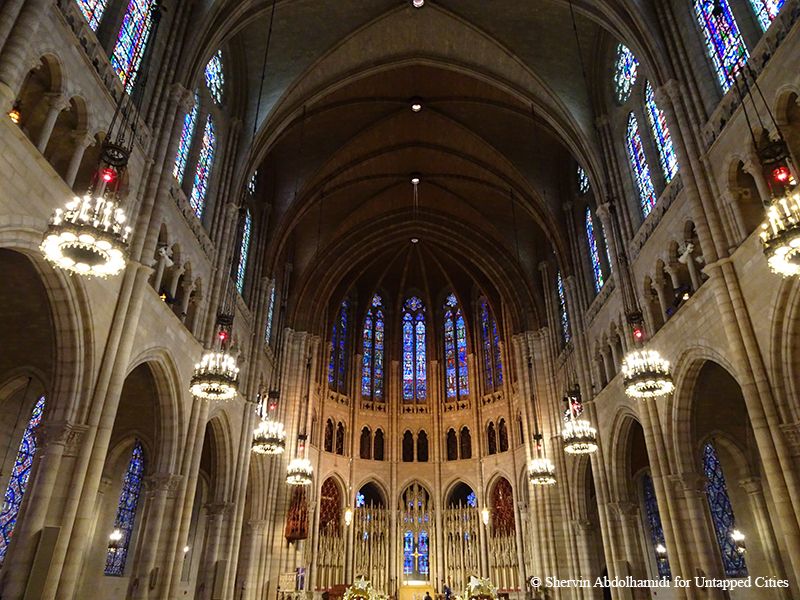
Henry C. Pelton, and Charles Collens of the firm Allen, Pelton, and Collens, were commissioned to travel across Spain and France to find inspiration for the church. The duo visited a multitude of churches before they chose two cathedrals; for the nave, they took inspiration from the 13th century Gothic Cathedral of Chartres, France, and their imposing bell tower they modeled after one of the towers Laon Cathedral – again in France.
In addition to calling from inspiration from European cathedrals, Riverside Church features some stained glass from a European cathedral. Over the stairwell in the far end of the narthex are four windows of stainless glass that portray the story of Christ. According to The History of Riverside Church in New York, These windows were originally installed in a 16th century cathedral in Bruges, Belgium. The glass was then moved to the chancel windows of the Park Avenue Baptist Church before being transferred to Riverside Church.
Think pigeons are a prodigious nuisance in New York? Well then surely you are a fan of the numerous fast-flying Peregrine Falcons that have made their homes in the tallest points of New York City. Peregrine Falcons are incredible birds of prey that have a flying speed of up to 60 miles per hour. These birds of prey prefer to live in lofty perches where they have an unobstructed vantage point of everything going on below. From there, they dive-bomb, swooping down to hunt their prey (predominantly pigeons) at up to 200 miles per hour.
Peregrine Falcons have made nested in various tall points in the city, such as the Brooklyn Bridge, Verrazano Bridge, Throgs Neck Bridge, George Washington Bridge, Metropolitan Life Building – and also Riverside Church. Peregrine Falcons have nested for decades on the bell tower of the church behind a gargoyle approximately three-quarters of the way up. The tower of the church has become a popular spot for falcon nests over the years, with birdwatchers able to spot baby falcons around early June, as they flap their wings to strengthen them for their first flight. The adults can be seen in the area all throughout the year
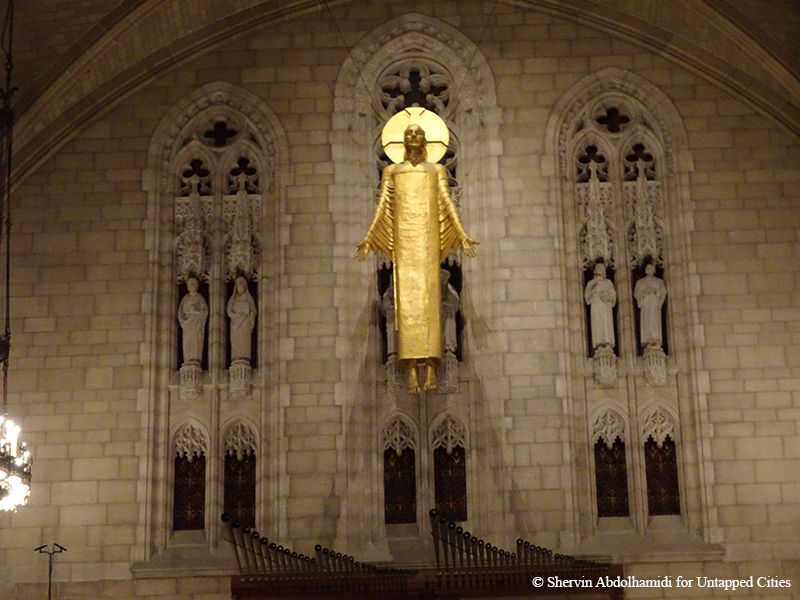
The original chancel and gallery organs for the Riverside Church were built by Hook and Hastings of Boston. In 1948 a new five-manual Aeolian-skinner chancel console was built. In 1967, Anthony A. Bufano built a new five-manual console, while at around the same time major tonal revisions were made. While the chancel console was being built, a second-hand Austin console was installed in the chancel.
A last cleaning was done in 1995-1996 when organ curator Robert Pearson supervised a complete cleaning, tuning and re-voicing of the organ to suit the new acoustical environment of the church.
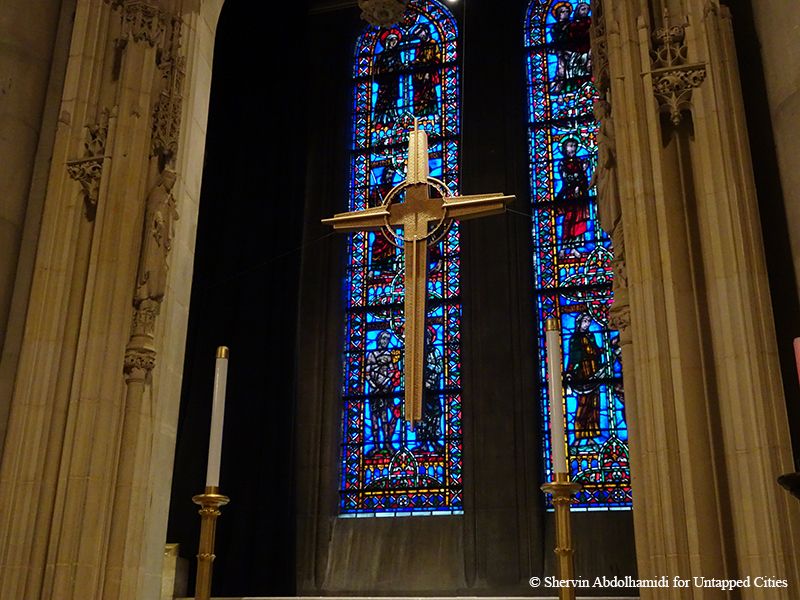
Riverside Church has had long, rich history of social activism throughout the years. As a church that prides itself on its interdenominational, multicultural principles, Riverside Church has task forces advocating for various causes: LGBT events and workshops are hosted in the church, immigrants’ rights movements strive to lobby for policies that would keep families of illegal immigrants together in the United States.
Being a beacon for social justice, Riverside Church served as a perfect venue for Martin Luther King Jr.‘s lesser remembered fight against the Vietnam War. On April 4th, 1967 Dr. King delivered his solemn, yet emphatic “Beyond Vietnam” speech where he voiced his opposition to the Vietnam War, stating, “If America’s soul becomes totally poisoned, part of the autopsy must read ‘Vietnam’.”
Dr. King’s speech came off the back of a strategic conundrum. While he had previously voiced concern about the war, the Vietnam War was being fought under President Lyndon Johnson’s leadership. President Johnson had been a great ally for Dr. King and criticizing him could have had led to repercussions. Nevertheless, Dr. King, guided by his quintessential moral compass, pushed ahead and delivered his speech, where he called the war, “an enemy of the poor” that was swallowing the nation’s young men and its resources for antipoverty programs like a “demonic, destructive suction tube.”
The speech incited severe backlash and harsh criticism from the media, and even some of his own allies. Martin Luther King Jr. was assassinated exactly one year later to the day, and while his antiwar campaigns were inconsequential to the course of the war (the war continued for eight more years), Dr. King’s “Beyond Vietnam” speech was again a testament to his belief in doing what was right, despite potential ramifications.
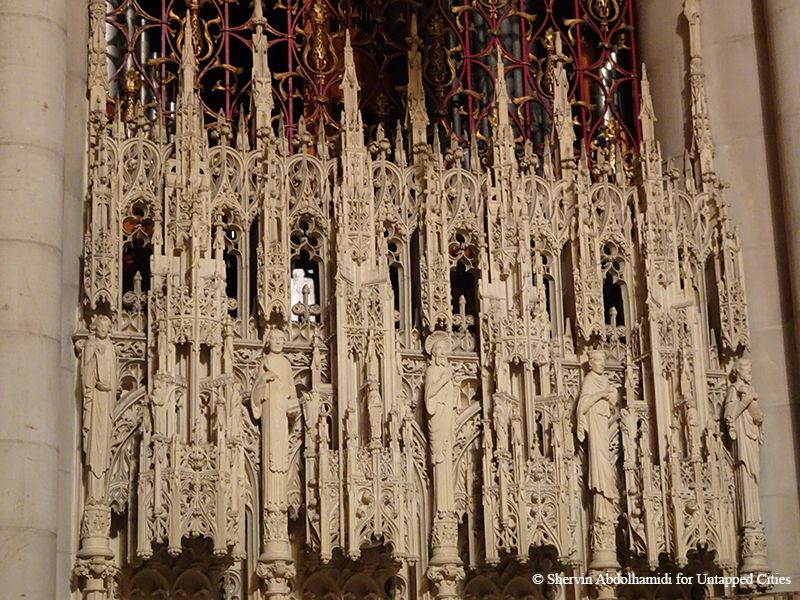
Riverside Church features a panel of statutes of scientists in what is called the “Arch of Scientists” at the West Portal of the church. Intriguingly, in addition to historic figures such as Galileo, Kepler, Newton, Archimedes, Faraday, Pasteur, and even Darwin, the arch also celebrates Albert Einstein, a contemporary figure at the time. Initially Einstein was not included but when the committee submitted their list of roughly twenty scientists to faculty members for recommendations, the faculty members persuade the committee to include Einstein in the list. Einstein later was surprised to learn that he was to be included in a portal in a Protestant church in New York City.
Einstein visited the church, and while he did not linger long before his own statute, he professed his appreciation in the inclusive philosophy of the church, as exhibited by the persons portrayed inside the church. Einstein admitted, “This could not happen in Europe. I am afraid it may never happen there.” Then after realizing that he was the only living person in all the symbolism, he proclaimed, “I’ll have to be very careful as to what I say and what I do for the rest of my life.”
In addition to scientists, many other non-Christian religious leaders and outstanding heroes are honored in Riverside Church. The tympanum arching the main portal contains figures of Confucius, Moses, Hegel, and Dante.
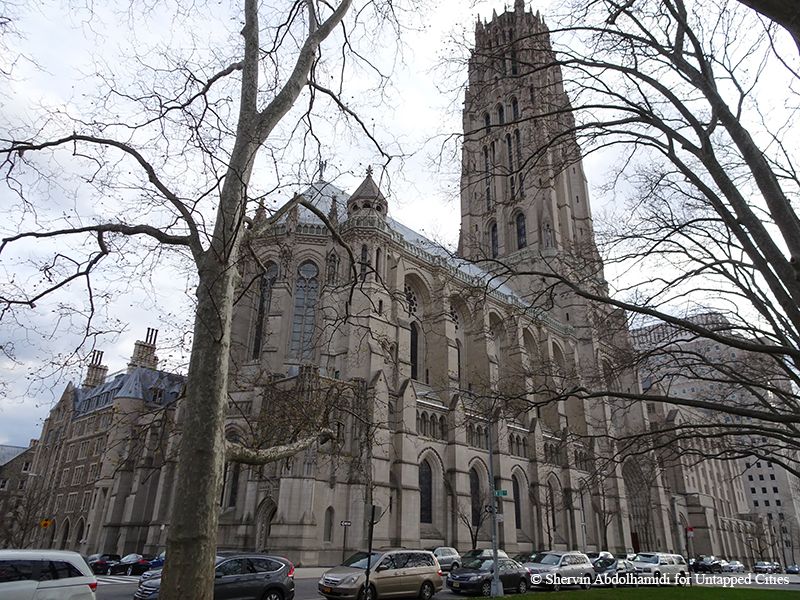
Minister Fosdick was the pastor of the Baptist church ministry at the Park Avenue Baptist Church, whose most famous member was John D. Rockefeller, Jr.. According to our tour guide at Riverside Church, Rockefeller and Fosdick developed a strong friendship overtime. Fosdick professed his desire for a church that would give “this educated community a place of greatest beauty for worship” and a place to “serve the social needs of the somewhat lonely metropolite”, and Rockefeller, who believed that New York City needed “a great Protestant cathedral” was very supportive of the project.
Rockefeller had previously supported plans for the construction of the Cathedral of St. John the Divine. However, the idea of a broader, more inclusive view of Christianity appealed to Rockefeller. Bishop of Manning of the Cathedral of St. John the Divine proclaimed that the time had not arrived when members of other denominations could join the board of the church so Rockefeller, a Baptist, was denied board membership. This prompted him to approach Fosdick concerning “an inclusive church” with no “specific denominational connotations.”
Fosdick agreed to be pastor under the condition that the church be near Columbia University. Thereby, Rockefeller and Fosdick started scouting land in the area and chose the south side of West 122nd Street between Riverside Drive and Claremont Avenue, on one of the highest points in Manhattan for their church. Three apartment buildings, as well as a mansion and a stable from the late 1800s were demolished to make room for the church. The church was built to advocate three principles that Rockefeller and Fosdick believed in: a church in an interdenominational setting, a large church in a neighborhood important to the city, and a church open to all who profess faith in Christ.
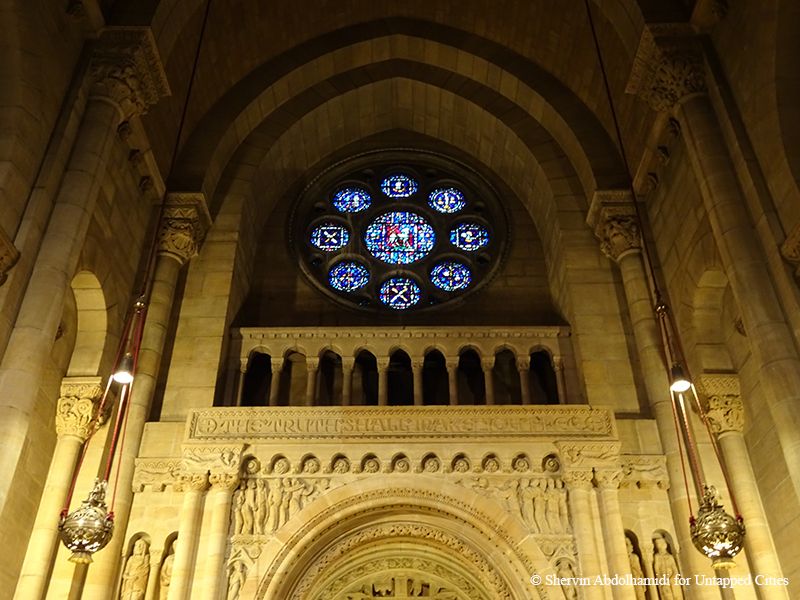
While Riverside Church was modeled after Chartres Cathedral, the two are similar only on an architectural level. Riverside Church is steel-framed structure with Gothic features, and so, the vaulting system in the great hall is decorative, rather than structurally essential. The modern structural elements of the church allowed it to be built at a fairly fast pace, with the first service being held a mere three years after construction started–despite being hindered early on by a scaffolding fire.
While the facade of Riverside Church is in the Gothic Revival style, the church is structurally modern – the 21-story tower has four elevators, the tallest in any church in the world, and parking space underneath it!
Nonetheless, there were some major design problems that had to be faced when designing the tower that are not necessarily visible to the naked eye. First, the weight of the bell chamber added an additional five floors to the weight of the tower. Therefore, some of the heaviest and thickest steel columns and beams used in the church were employed in the structure of the tower.
The second major problem was the necessity of having one edge of the tower in a juxtaposition with the nave. Essentially, the entire north wall of the tower had to be carried on one truss beam resting on upright columns that were placed on either side of the nave. This cross truss is 68 feet long and weighs 60 tons.
Next, check out the Top 10 Secrets of the Cathedral of St. John the Divine.
Subscribe to our newsletter